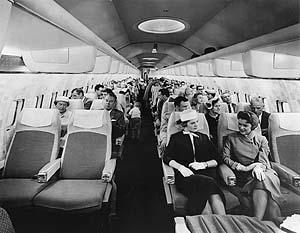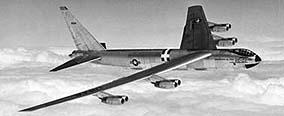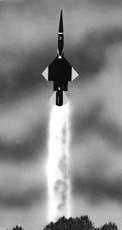 |
Actors posed for 1956 promotion photos in the spacious comfort of a 707 Stratoliner cabin mock-up. Photo Credit: The Boeing Co. |

At left, a B-52 Stratofortress long-range bomber flies above the clouds. Photo Credit: The Boeing Co.
IN 1956, THE BOEING PAYROLL PUMPED NEARLY $8.5 MILLION into the local economy every
two weeks. About 35,000 King County men and women worked for The Big B -- slightly more than half
of all manufacturing employees in the metropolitan area. Only curmudgeons fretted about local
dependence on one company.
Seattle was just plain happy to be Boeing's company town, proud of the industry
giant that had grown from modest 1916 beginnings in the old Heath shipyard on Lake Union.
The Times provided eager coverage of Boeing's resurgence as a Cold War military contractor
-- for B-47 Stratojet and B-52 Stratofortress jet bombers -- and as a developer of jetliners for the
commercial airlines. Longtime Boeing-watcher Bob Twiss followed the home-grown success story for Times readers,
rooting for the company all the way. After all, "As Boeing goes," the local joke ran, "so goes Seattle.
And Bellevue. And Bothell. And Renton. And so forth."
From 1955 on, the race between Boeing 707 Stratoliners and Douglas Aircraft
Company DC-8s to win the commercial jet transport market made monthly headlines in The Times.
In 1959, 1.5 million air travelers passed through Seattle-Tacoma Airport,
putting to rest earlier fears that air travel would remain a luxury and the airport would be an
empty failure. Instead, commercial jet flight was a raging success: Twiss noted in a 1959 year-end
economic review that Boeing had booked orders for nearly 200 707s.
 In the '50s, local affluence
depended on sales of Boeing jets to both the U.S. Cold War arsenal and the civilian transportation industry.
At right, a Bomarc missile streaked
skyward at an Air Force test center. Photo Credit: The Boeing Co.
In the '50s, local affluence
depended on sales of Boeing jets to both the U.S. Cold War arsenal and the civilian transportation industry.
At right, a Bomarc missile streaked
skyward at an Air Force test center. Photo Credit: The Boeing Co.
PRESIDENT EISENHOWER'S PROPOSED DEFENSE BUDGET
FOR BOEING PROJECTS in 1960 made headlines in Seattle. The contracts
totaled more than $1 billion and included 72 LC-135 jet tanker-transports,
40 B-52H Stratofortress bombers, a secret number of Superbomarc missiles
and nearly $500,000 for the DynaSoar, Boeing's candidate for the manned
space program.
The aerospace giant's military contracts were a big
story, but so was the 707 jetliner. In 1956, Boeing had depended on
federal money for 98 percent of its business but in 1960, more than
50 percent of the company's revenue would come from commercial sales.
Outside the Seattle area, most state residents earned their living in
agriculture and resource-based industries. And those people were doing
well, too: In 1959, Washington wages exceeded $6 billion -- a record to
that date.
In Seattle, local retail sales nearly doubled and the average
family income increased from $5,255 to $7,042 -- a 34 percent jump
-- during the boom between 1951 and 1960.
Seattle's streets and shops were bustling:
its theaters, restaurants and cultural institutions more
sophisticated and cosmopolitan. The Alaskan Way viaduct was
completed along the waterfront, and the Washington, Logan and
Norton buildings changed the city's skyline. Seattle had grown north
to 145th Street, and new residential subdivisions followed.
New shopping malls, such as Northgate and Bellevue Square,
drew branches of downtown department stores.
Confident, the metropolitan area tackled some of
its enduring problems: the argument over a north-south superhighway
through town and another on the Eastside; the issue of a second
floating bridge; cleaning up a polluted Lake Washington; what to
do about King County's antiquated system of government.
There was even enough optimism to consider
holding a world's fair.
Critics have called these years the Fatuous Fifties,
deriding the complacent culture of materialism, respectability
and conformity. But local prosperity didn't just drive the
purchase of decorator phones and big-finned cars -- it
encouraged a surge of civic energy that transformed the city.
Historians Sharon Boswell and Lorraine McConaghy teach at local
universities and do research, writing and oral history. Original
newspaper graphics courtesy of the Seattle Public Library.